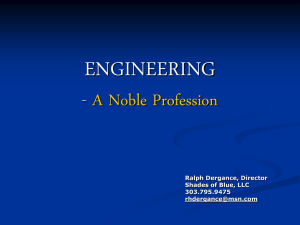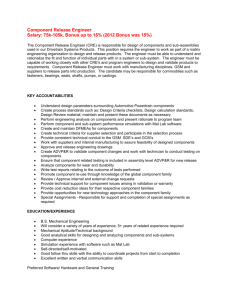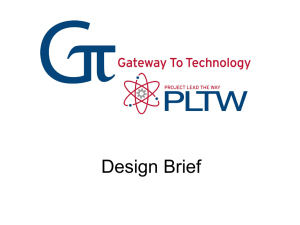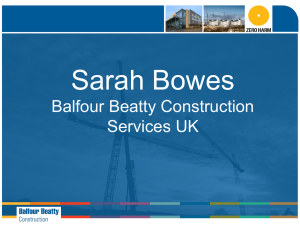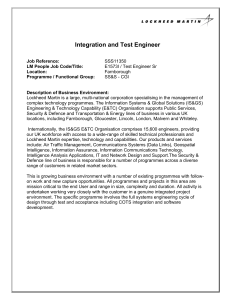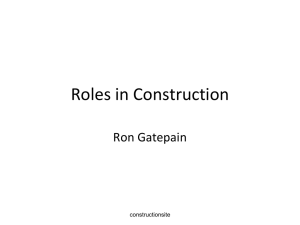section 704 temporary traffic control 704.01 description
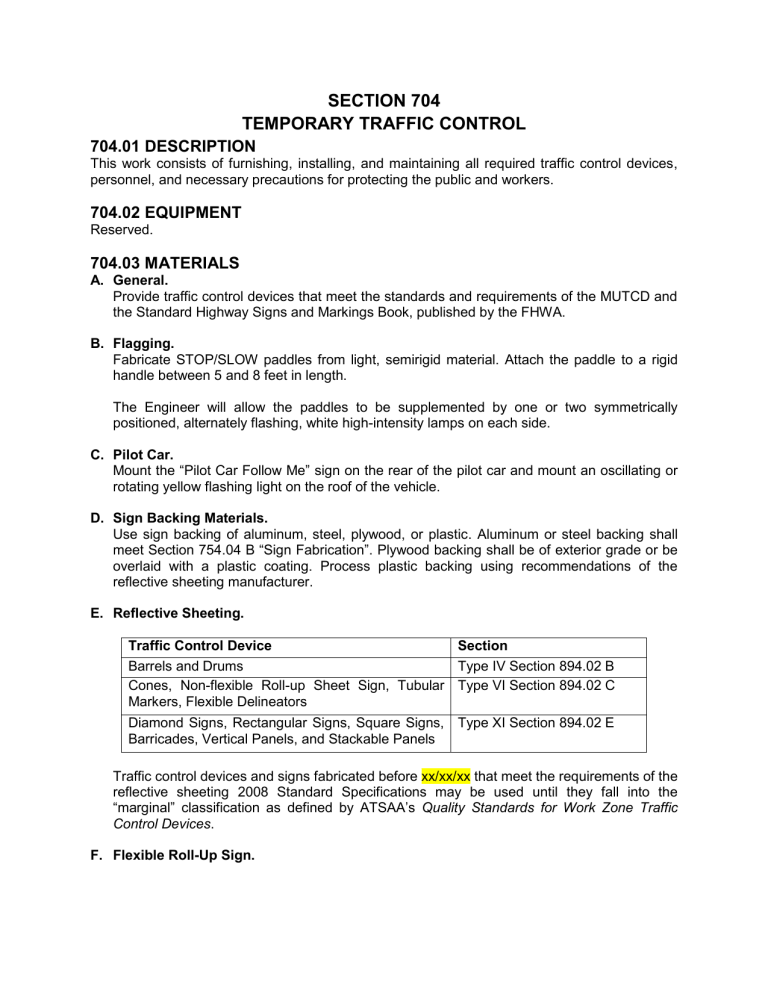
SECTION 704
TEMPORARY TRAFFIC CONTROL
704.01 DESCRIPTION
This work consists of furnishing, installing, and maintaining all required traffic control devices, personnel, and necessary precautions for protecting the public and workers.
704.02 EQUIPMENT
Reserved.
704.03 MATERIALS
A. General.
Provide traffic control devices that meet the standards and requirements of the MUTCD and the Standard Highway Signs and Markings Book, published by the FHWA.
B. Flagging.
Fabricate STOP/SLOW paddles from light, semirigid material. Attach the paddle to a rigid handle between 5 and 8 feet in length.
The Engineer will allow the paddles to be supplemented by one or two symmetrically positioned, alternately flashing, white high-intensity lamps on each side.
C.
Pilot Car.
Mount the “Pilot Car Follow Me” sign on the rear of the pilot car and mount an oscillating or rotating yellow flashing light on the roof of the vehicle.
D. Sign Backing Materials.
Use sign backing of aluminum, steel, plywood, or plastic. Aluminum or steel backing shall meet Section 754 .04 B “Sign Fabrication”. Plywood backing shall be of exterior grade or be overlaid with a plastic coating. Process plastic backing using recommendations of the reflective sheeting manufacturer.
E. Reflective Sheeting.
Traffic Control Device Section
Barrels and Drums
Cones, Non-flexible Roll-up Sheet Sign, Tubular
Markers, Flexible Delineators
Type IV Section 894.02 B
Type VI Section 894.02 C
Diamond Signs, Rectangular Signs, Square Signs,
Barricades, Vertical Panels, and Stackable Panels
Type XI Section 894.02 E
Traffic control devices and signs fabricated before xx/xx/xx that meet the requirements of the reflective sheeting 2008 Standard Specifications may be used until they fall into the
“marginal” classification as defined by ATSAA’s Quality Standards for Work Zone Traffic
Control Devices .
F. Flexible Roll-Up Sign.
Mount flexible roll-up signs in a frame that keeps the sign flat and in proper position for viewing by the motorist. Attach the frame to a portable stand for placement on the roadbed.
Weight the stand or design it to be stable.
G. Barricades.
Construct barricades of lightweight materials and cover both sides of the barricade rail surface with reflective sheeting.
Use aluminum rails that meet the requirements in ASTM Designation B 221, Alloy 6063-T6.
H. Delineator Drums.
Use delineator drums that are constructed of durable plastic with horizontal, circumferential, orange and white reflectorized stripes.
Weight the delineator drums or design them to be stable.
I. Stackable Vertical Panel.
Use stackable vertical panels that are constructed of hollow low density polyethylene orange plastic that is held in an upright position by a molded rubber base.
Use stackable vertical panels that are a minimum of 43 inches high and have a minimum bottom dimension of 15 inches by 9 inches.
Use stackable vertical panels that have a minimum weight of 4 pounds. Use a molded rubber base with a minimum weight of 30 pounds.
Provide reflective sheeting on both sides of the stackable vertical panels using the striping pattern and dimensions specified for vertical panels in the MUTCD.
Provide stackable vertical panels that meet the requirements of NCHRP Report 350 or
MASH as a Category II Traffic Control Device.
J.
Traffic Cones.
Use orange traffic cones fabricated from impact resistant materials.
Weight the traffic cones or design them to be stable.
K. Delineators.
Equip each delineator with an acrylic plastic or reflective sheeting reflector mounted on a post support.
L. Portable Precast Concrete Median Barriers.
Unless the Department furnishes the barriers, provide barriers that meet the requirements of
NCHRP Report 350 or MASH.
M. Warning Lights.
Use warning lights that are portable, lens directed and enclosed. Use warning lights that meet the requirements of Purchase Specifications for Flashing and Steady Burn Barricade
Warning Lights published by the Institute of Traffic Engineers and the requirements of Table
704-01.
Type A
Table 704-01
Low Intensity
Type B Type C
High Intensity Steady Burn
Lens Directional Faces 1 or 2 1 1 or 2
Flash Rate Per Minute
Flash Duration 1
Min. Effective Intensity 2
55 to 75
10%
55 to 75
8%
Constant
Constant
4.0 Candles 35 Candles
Min. Beam Candle Power 2 2.0 Candles
Hours of Operation Sunset to Sunrise 24 hrs./day Sunset to Sunrise
1
2
Length of time that instantaneous intensity is equal to or greater than effective intensity.
These values shall be maintained within a solid angle 9 degrees on each side of the vertical axis, and 5 degrees above and below the horizontal axis.
N. Advance Warning Flashing or Sequencing Arrow Panels.
Use advance warning arrow panels that meet the requirements of Table 704-02.
Table 704-02
Type
Minimum Size
(Inches)
24 x 48
Minimum No. of
Panel Lamps
12
Minimum Legibility
Distance 1
1/2 Mile A
B
C
30 x 60
48 x 96
13
15
3/4 Mile
1 Mile
1 Minimum legibility requirements are the distances at which the arrow panel message can be comprehended by a driver on a sunny day or a clear night .
Provide panel faces with a black, non-reflective finish.
Mount panels on a vehicle, trailer, or other suitable support. If using vehicle mounted panels, equip the panels with remote control capabilities.
Equip arrow panels with one of the following mode selections:
Left or right flashing or sequencing arrows and double flashing arrows; or
Left or right sequencing chevrons and caution.
Provide automatic light dimming controls capable of reducing rated lamp voltage a minimum of 50 percent on each arrow panel. Control the dimming with a photoelectric cell that operates between sunset and sunrise. Use arrow panel lamps that flash at a rate between
25 and 40 flashes per minute.
Use lamps that have a minimum
“on” time of 50 percent for the flashing arrow and
25 percent for the sequential chevron.
Recess mount the arrow panel lamps or lenses or equip them with an upper hood of not less than 180 degrees. Use lamps that emit yellow light.
O. High-Level Warning Device.
Use a warning device consisting of a minimum of 3 flags. If specified, add a Type B highintensity flashing light to the device.
Construct the device so the distance from the roadway to the bottom of the flasher lens or the lowest point of all 3 flags shall be at least 8 feet. Use orange or fluorescent red-orange flags that are a minimum of 16 inches by 16 inches.
704.04 CONSTRUCTION REQUIREMENTS
A. General.
At the preconstruction conference provide a certificate of compliance stating that category I and II traffic control devices meet NCHRP 350 or MASH Guidelines. Attach approved shop drawings for the traffic control.
Furnish, install, maintain, and remove the required traffic control devices to the certificate of compliance.
Place traffic control devices to meet the standards and requirements of the MUTCD and the
Standard Highway Signs and Markings Book, published by the FHWA.
Have all required devices available for installation when needed and maintain, relocate, cover, or remove as necessary.
Provide personnel as required.
If the placement of work zone signs interferes with permanent signs, place the work zone signs at an approved location. Revisions to sign messages may be required.
If the Engineer notifies the Contractor of the need for traffic control to be furnished, installed, relocated, maintained, removed, or otherwise revised and the Contractor has not performed the work as notified within 24 hours, the Engineer will perform any combination of the following:
1. The Engineer will apply a contract price reduction of $1,000 per day.
2. The Engineer will have the work completed by other means, without additional notification, and deduct the cost of the work from monies due or to become due the
Contractor.
3. The Engineer will direct all other work to cease until the deficiencies have been corrected.
Only place traffic control devices that are applicable to actual conditions of the project site.
Remove devices once they are no longer necessary for the public’s use. Remove sign bases at the same time that sign faces are removed.
If signs are place on fixed supports, except those located behind a barrier or crash cushion, use breakaway supports that meet the requirements of the AASHTO Roadside Design
Guide, Chapter 4 Section 4.1. For items not detailed on the standard drawings, provide documentation showing the supports meet the requirements of AASHTO Roadside Design
Guide, Chapter 4 Section 4.1.
1. Initial installation of Traffic Control Devices.
Classify traffic c ontrol devices as “acceptable”, “marginal”, or “unacceptable” using
ATSAA’s Quality Standards for Work Zone Traffic Control Devices .
If traffic control devices are designated to remain the Department’s property upon project completion, the devices must be new when installed on the project and must be classified as “acceptable” when the Department takes possession. If devices are not classified as “acceptable” when the Department takes possession, provide identical devices that meet the “acceptable” designation at no additional cost to the Department.
For traffic control devices that are to remain the property of the Contractor upon project completion, provide devices that are classified as “acceptable” when installed on the project. Provide a written certification that all devices are classified as “acceptable”.
2. Maintenance and Replacement of Traffic Control Devices.
For each type of device used, except warning lights, a maximum of 25 percent of the quantity may fall into the “marginal” classification during the course of the work. Replace devices as needed so that at least 75 percent of the devices remain classified as
“acceptable”. Replace any warning lights that become classified as “unacceptable”.
Install replacement devices that are classified as “acceptable” within 12 hours of noting that the previously installed device falls below the specified classification limit.
Replace devices not covered by ATSAA’s Quality Standards for Work Zone Traffic
Control Devices when they are no longer in an operable condition.
Clean traffic control devices as necessary to maintain the proper brightness of reflectorized material or warning lights.
B. Personnel.
Before beginning the work, coordinate and hold a meeting with the Engineer to review the traffic control plans.
The traffic control supervisor and traffic signal maintenance person shall be able to access the project site within one hour of notification and be “on call” on a 24 hour basis.
1. Traffic Control Supervisor.
If designated in the plans, provide a traffic control supervisor.
If the designated traffic control supervisor becomes unavailable, designate a replacement supervisor. a. Qualifications.
Designate a traffic control supervisor that:
1. Has completed a traffic control course as outlined in Section 704.04 B.1.c “Traffic
Control Course.”
2. Is familiar with the requirements of the Department traffic control plans and specifications.
3. Has a total of at least 12 months experience with traffic control plans, layouts and maintenance.
4. Is competent to supervise personnel in traffic control operations. b.
Duties.
The traffic control supervisor shall:
1. Provide traffic control as required
2. Perform a daily inspection of the installation, operation, maintenance, and removal of all traffic control devices. Provide documentation within 24 hours of each inspection.
3. Correct traffic control conditions that cause erratic vehicle movements, unexpected braking, etc.
4. Propose changes to improve traffic flow through the work zone. c. Traffic Control Course.
A 16 hour minimum traffic control course shall be one of the following:
ATSSA Traffic Control Supervisor Course;
AGC Traffic Control Supervisor Course;
NHI ’s Design and Operation of Work Zone Traffic Control ; or
Approved subject courses with a minimum of 3 hour per subject of the following(combined total must be at least 16 hours): o Manual and standard signs used in work areas; o Channelizing devices and temporary barriers, pavement markings, lighting devices, arrow displays and special devices, and devices location and placement; o Layout for traffic control devices, motorist characteristics, and options and alternatives; o Installation and removal of the traffic control zone, and operation and maintenance of the traffic control zone; and o Flagging operations, legal liability and record keeping, and emergency situations.
Each course or subject course shall include a workshop covering:
Design problems;
Installation and removal; and
Operations and maintenance.
Each workshop shall also include a question and answer portion.
A valid Minnesota Department of Transportation Traffic Control Supervisor
Certification will be accepted in lieu of traffic control courses listed above.
2. Watchperson.
Provide a watchperson that patrols the project to ensure that the traffic control devices are properly placed. If the plans specify a traffic control supervisor, the traffic control supervisor may be designated as the watchperson.
The watchperson shall patrol the project at least twice per day, once in the morning before work begins and once in the evening after work is complete for the day. The watchperson shall patrol the project twice per day on days when no work is in progress, once each morning and once each evening before sunset.
Provid e documentation of the watchperson’s hours and activities.
Immediately assist the watchperson to correct conditions that cause erratic traffic movement, unexpected braking, etc., and erect, repair, replace, or relocate the required traffic control devices.
The Engineer will allow suspension of watchperson service during periods of authorized suspension or after substantial completion of the work, provided the job site is in safe condition.
3. Traffic Signal Maintenance Person.
If permanent or interim traffic signals are being installed, designate a traffic signal maintenance person. This person is in addition to the traffic control supervisor and the watchperson as specified in Sections 704.04 B.1
“ Traffic Control Supervisor” and 704.04
B.2 “Watchperson”.
The traffic signal maintenance person shall be responsible for maintenance of interim and permanent traffic signals.
4. Emergencies.
Immediately contact the Engineer, Highway Patrol, and local law enforcement agencies of any emergency situation.
Provide written documentation to the Engineer, Highway Patrol, and local law enforcement agencies of the name, address, and phone number of the:
Superintendent as outlined in Section 105.02 “Contractor Requirements”;
Traffic Control Supervisor as outlined in Section 704.04 B.1
“ Traffic Control
Supervisor”;
Watchperson as outlined in Section 704.04 B.2 “Watchperson”; and
Traffic Signal Maintenance Person as outlined in Section 704.04 B.2 “Traffic
Signal M aintenance Person.”
If the any of the listed personnel change, provide written notification to the Engineer
Highway Patrol, and local law enforcement agencies the new name, address, and phone number with 24 hours of the change.
5. Flaggers.
Provide flaggers that have viewed the flagging training video and passed the flagging written examination. Before an individual will be allowed to perform flagging, the
Engineer must receive written verification the individual has viewed the video and passed the written examination.
Furnish each flagger with the North Dakota Flagging Handbook. Ensure each flagger observes the rules and regulations contained in the North Dakota Flagging Handbook. If there are any differences between the requirements in the handbook and specifications, the specifications will govern over the handbook. The Department will furnish the handbook upon request and it is available for download at www.ndltap.org
.
Do not assign flaggers other duties while working as authorized flaggers.
If flagging is performed after sunset, provide each flagger with a flashlight topped with a transparent red glow cone and a reflectorized STOP/SLOW paddle. Illuminate the flagger’s location using floodlights as specified in Section 704.04 L.7, “Floodlights”.
6. Pilot Car.
Use a pilot car to guide vehicles through or around the construction area when traffic is reduced to a single lane. At each end of the single lane section, coordinate the pilot car operation with flagging operations or other controls.
C. Signing.
1. Project Terminal Signing.
Before starting work, erect the required traffic control devices at each end of the project and at various locations within the project as shown on plans. Leave these devices in place and maintain them for the duration of the contract.
2. Work Area Signing.
Do not start construction work until the proper traffic control devices for the work area are in place. If no details are provided for the particular type of construction work involved, install traffic control devices according to the MUTCD or as directed by the
Engineer.
If additional signing is required due to Contractor operations:
Furnish flaggers at no additional cost to the Department until the additional signs are installed; or
Cease construction operations in that area until the additional signs are installed.
Maintain two way traffic when practicable. Direct one way traffic using flaggers or maintain it under control of an approved traffic signal system.
Relocate, remove, or change traffic controls devices so that the devices match the actual conditions of the project site.
When no work is in progress, completely cover or remove signs that are only necessary when work is being performed.
Only use portable signs for operations that are to be completed in 5 days or less. If the
Engineer determines that the portable signs are unsafe or that the operation will take longer than 5 days, replace the portable signs with post mounted signs. If a portable sign must be placed on a paved surface, the sign may be in place for more than 5 days.
If portable signs are trailer mounted, use trailers that meet the crash test requirements of
NCHRP Report 350 or MASH.
Place portable signs on the shoulder or outside of the traveled lane without posing a hazard to traffic and in clear view of oncoming traffic without sight obstructions.
When portable signs are not in use:
Move the signs a minimum of 45 feet from the edge of the traveled lane and placed so that the message cannot be read by traffic; or
Lay the signs face down on the inslope. Only lay signs on the inslope if the laydown height is 6 inches or less.
3. Existing Signs.
Immediately reset existing regulatory traffic signs that must be moved to accommodate construction activities.
4. Route Markers.
The Department will furnish necessary route marker signs. Furnish all necessary hardware to install the Department furnished signs.
Install the Department furnished route marker signs on Contractor furnished posts.
D. Barricade and Vertical Panel Application.
1. General.
Barricade rails and vertical panels with stripes that begin in the upper right corner and slope down and to the left are “right” devices. Install “right” devices on the right side of a traffic lane. Barricade rails and panels with stripes that begin in the upper left corner and slope down and to the right are “left” devices. Install “left” devices only on the left side of a traffic lane.
2. Barricades.
Use Type I or Type II barricades to mark a specific hazard or to channelize traffic. If using Type I or Type II barricades to channelize traffic, install barricades so that they face the oncoming traffic.
When closing a section of road, install Type III barricades at the points of closure.
Extend the Type III barricades completely across the roadway including the shoulders or from curb to curb.
If access for equipment and authorized vehicles is necessary, use Type III barricades with gates or movable sections that can be closed when work is not in progress, or with indirect openings that discourages public entry.
If the road is closed, but access to local traffic must be furnished, arrange the Type III barricades to permit local traffic only.
Do not use Type III barricades to channelize traffic.
If the construction limits encroach onto pedestrian routes and the pedestrian traffic cannot be diverted to other existing pedestrian routes, install Type III barricades to define the temporary pedestrian access.
3. Vertical Panel.
Use vertical panels that are faced on both sides as channelizing devices, warning devices, or windrow markers.
4. Stackable Vertical Panel.
Use stackable vertical panel to channelize traffic.
E. Drum Application.
Use drums to channelize or delineate traffic flow or to mark specific hazards.
F. Traffic Cone and Tubular Marker Application.
Use traffic cones and tubular markers to channelize traffic. Use additional weighting as required to prevent overturning or displacement by wind.
G. Flexible Delineator Application.
If using a two-sided delineator, keep the wide side of the delineator towards traffic. If the delineator is to be seen by side traffic, use an additional delineator with its wide side placed facing the side traffic. The Engineer will not measure the additional delineator for payment.
H. Delineator Application.
Use delineators within project site for traffic guidance. Do not use delineators as warning devices.
Mount delineators on supports so the reflector is 4 feet above the roadway edge. Use white reflectors for delineators installed along the right side of the road. Use yellow reflectors for delineators installed along the left edge of divided streets, divided highways, and one-way roads.
Along roadway curves, space delineators as specified in the MUTCD.
I. Portable Barrier Application.
If installing warning lights on portable barriers, use Type A flashers for the first two warning lights on each side of the roadway, and use Type C steady burn lights for the subsequent lights on the barrier.
J. Precast Concrete Median Barrier (State furnished).
At least two weeks before taking control of State furnished barriers; notify the Engineer of the date control will be taken.
Before taking control of the barriers, perform and document the inventory with the Engineer of all barriers and associated materials to be received. Both parties must sign and date the inventory. Each party must retain a signed copy of the inventory.
At least two weeks before transporting barriers to the designated storage location, notify the
Engineer of the transportation date.
After completing delivery, perform an inventory with the Engineer of the barriers and associated materials, and document the results. Replace any barriers or materials that have been damaged or lost at no additional cost to the Department. After any replacement items have been delivered, the Engineer and the Contractor will sign and date the inventory and both parties will retain a copy.
K. Lighting Device Application.
1. General.
Use flashing and steady burn lights on signs, drums, vertical panels, and barricades when Type III, Type IV, or wide angle prismatic reflective sheeting is not used.
2. Flashing Lights (Type A, Low-Intensity).
Use Type A low-intensity flashers to warn drivers that they are approaching or traveling in a hazardous area.
3. Flashing Lights (Type B, High-Intensity).
Use high-intensity flashers at extremely hazardous site conditions. Operate the highintensity flashers 24 hours per day.
4. Steady-Burn Lights (Type C).
Use steady-burn warning lights to delineate the edges of the traveled way on detour curves, on lane changes, and along tapers.
5. Mounting Height of Warning Lights.
Mount warning lights on: a. Barricade and portable barriers with a minimum height of 36 inches from the bottom of the lens to the roadway. b. Signs with the bottom of the light housing between 2 and 12 inches above the top of the sign. c. Vertical channelizing devices and independent supports between 4 and 5 feet above the pavement.
6. Advance Warning Arrow Panels.
Use sequencing arrow panels to provide advance warning and directional information to assist in diverting and controlling traffic at the project site. Use other traffic control devices as necessary in conjunction with the sequencing arrow panel.
During nighttime operations, use an automatic dimmer on the lamps to dim them to 50 percent of the output.
7. Floodlights.
If construction activities are performed at night, provide floodlighting for the construction area and flagger stations. Adequately illuminate the area without creating glare in the eyes of drivers.
L. High-Level Warning Device.
Use high-level warning devices to supplement other controls and devices. Use high-level warning devices in urban high-density traffic situations.
704.05 METHOD OF MEASUREMENT
The Engineer will measure as specified in Section 109.01 “Measurement of Quantities” and as follows:
A. Traffic Control Signs.
The Engineer will include all posts and mounting hardware in the measurement of the traffic control signs.
B. Traffic Control Devices.
The Engineer will only measure traffic control devices that were authorized by the Engineer before their installation. The Engineer may authorize but will not measure devices beyond the quantity included in the plans that become necessary due to the Contractor’s methods or work sequence. This includes instances where the type of operation is included in the work area layouts included in the plans.
704.06 BASIS OF PAYMENT
A. General.
If an Engineer order or a contract revision necessitates the relocation of signs mounted on fixed supports, the Engineer will determine the number of sign units that were relocated and the Department will pay the Contractor for 50 percent of those units at the contract unit price as payment for the relocation.
The Department will not make payment for any existing traffic control devices that are turned away, covered, taken temporarily out of service, and then returned to use.
The Department will not make payment for any traffic control devices relocated as required by construction operations.
Pay Item Pay Unit
Flagging
Traffic Control Sign
Lane Closure – Signal Control/Flagging Control
Attenuation Device – Type B - __
Type __ Barricade
Delineator Drums
Traffic Cones
Tubular Markers
Delineator
Flexible Delineators
Stackable Vertical Panels
Vertical Panels – Back to Back
Sequencing Arrow Panel – Type __
Traffic Control
Pilot Car
Man Hour
Unit
Each
Each
Each
Each
Each
Each
Each
Each
Each
Each
Each
Lump Sum
Hour
Portable Precast Concrete Median Barrier
Portable Precast Concrete Median Barrier
– State
Furnished
Portable Changeable Message Sign
B. Lump Sum Traffic Control.
If traffic control is included in the contract as a lump sum, the Department will make payment based on the contract unit price the schedule in Table 704-03.
Table 704-03
Percent of Contract Unit Price
Paid to Date
40 Percent
50 Percent
75 Percent
Time
At installation
LF
Each
Each
When Contract is 25% complete
99 Percent
100 Percent
C. Special Nonstandard Signs.
When Contract is 50% complete
When Contract is 75% complete
When Contract is complete
If the Contractor is required to furnish special nonstandard signs that are not included in the
Contract, the Contractor and the Engineer must agree to a unit value for the special nonstandard signs, and payment will be made according to the contract unit price per sign unit and the special nonstandard sign will become property of the Contractor.
If a unit value cannot be agreed upon, the Department will make payment at invoice price plus 15 percent, and the special nonstandard sign will become the Departm ent’s property after it has been removed from service.
The Department will make payment for sign supports and installation of special nonstandard signs according to Section 104.
02 “Contract Revision.”
D. Precast Concrete Median Barrier (State furnished).
The Department will make payment for Precast Concrete Median Barrier (State furnished) as follows:
50 percent of the contract unit price will be paid when the barriers have been placed on the project site.
The remaining 50 percent of the contract unit price will be paid when the barriers have been removed from the project, transported to the storage area designated in the Contract and accepted by the Engineer with all applicable hardware accounted for in the Contractor provided written inventory.
Include the cost of obtaining, transporting, installing, moving, and maintaining the barriers in the state furnished precast concrete median barrier bid item.
